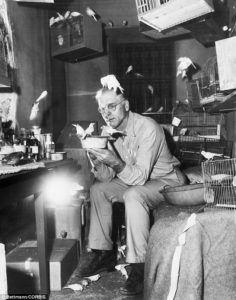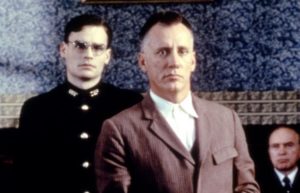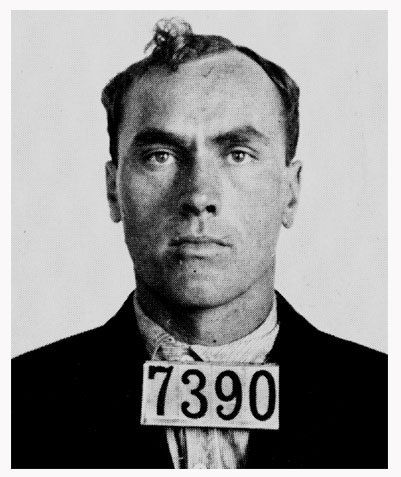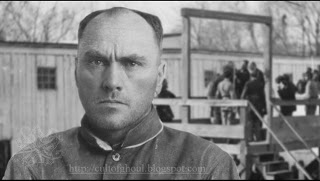I’m currently working on a new book (new, as in I have an OLD book and you should probably go buy a copy because my publisher deserves money for enduring my head-casery) and as I research I keep finding interesting alleys off the main street of my reading. So many little snippets that likely won’t have a place in the larger story but are entertaining enough that I want to share them.
My upcoming book will be a look at personal manifestos and their role in shaping particular parts of contemporary culture as well as serving as at times unintentional autobiographies of the people who wrote them. Less Karl Marx’s Communist Manifesto and more Elliot Rodger’s My Twisted World. Some of the manifestos I am analyzing are quasi-political, like Valerie Solanas’ The SCUM Manifesto or Anders Behring Breivik’s 2083, but most of them are analyses of the self that also stand as a statement or declaration of social or political aims. One such manifesto is Carl Panzram’s autobiography, wherein he discusses how he came to be shaped into a multipurpose psychopath and why he felt entitled to engage in the mayhem that saw him imprisoned multiple times and ultimately executed. As I researched Carl Panzram, I came across Panzram: A Journal of Murder by Thomas E. Gaddis and James O. Long, editors, and an unexpected look at how the politics of the death penalty played out among the condemned.
Before he was The Birdman of Alcatraz, Robert Stroud was The Birdman of Leavenworth (which actually makes more sense as a moniker since he was never permitted to keep birds at Alcatraz).

The movie about him, starring Burt Lancaster, was before my time and I probably should watch it in due time, but from what I can tell it portrays Stroud in a very sympathetic manner (as does a more recent film about Panzram that stars James Woods).

But bear in mind, if Carl Panzram, dream date of late-child murderer Ian Brady, was a one-man-mayhem-machine, Robert Stroud, had he stayed out of prison longer, would have been his peer. Though he spent decades nursing birds and researching cures for avian diseases at Leavenworth, Stroud was also a pimp and a murderer, and once imprisoned he was the instigator of many fights and eventually killed a prison guard. That murder landed him on death row at Leavenworth, but his sentence was commuted and he spent 1918 through 1942 in solitary confinement at Leavenworth (which sounds much different than what prisoners experience in solitary in the USA today). It was in solitary confinement in Leavenworth that Stroud “met” Carl Panzram.
Oh, and in case you were wondering how Stroud ended up in Alcatraz, the Birdman was caught using the equipment a benevolent prison warden gave him for his birds to make alcohol and sell within the prison. Upon discovery of this side hustle, he was transferred to Alcatraz.

Carl Panzram was a life-long criminal and an utter psychopath whose crimes ranged from audacious financial exploits on oil rigs in Africa to child rape to murder. A victim of the harsh practices in reform schools and even harsher practices in prison, all attempts to rehabilitate him made him even worse. He’d been in several prisons before ending up in Leavenworth, often under false names. Panzram in prison was a man who just wanted to be left alone. It’s hard to be left alone in prison and Panzram, in Leavenworth, became a pot waiting to boil over. He reached his limit and started a prison riot when he killed the foreman in the prison laundry. That earned him the death penalty and he was kept in solitary during his trial and the time during which he was awaiting execution, in the same solitary block as Robert Stroud.
(There’s a funny story about the end of the riot, too. Or at least it was funny to me. Panzram beat the prison laundry foreman to death with a pipe and rampaged through the prison with it in his hand. When he reached a wing that a guard, Red Ballard, locked down anticipating his arrival, Panzram shouted at him to open the door. Ballard, terrified and shaken, said, “I will never let you in with that in your hand.” As if he forgot he was holding it, Panzram tossed the iron bar away and declared that this must be his lucky day. Ballard called for assistance and, presumably, opened the door.)
During the trial, Panzram was clear that he wanted to be executed. Many anti-death penalty groups tried to intervene on his behalf and in response Panzram essentially told them to take their do-gooder notions and go fuck themselves. He was set on execution, not only because he was tired of the misery of prison life, but also in the spirit of telling the state and the penal system that since they created this monster, they needed to kill it. A sort of slow-motion suicide by cop.
This attitude alarmed Robert Stroud to the point that he intervened. Or at least he tried. Despite both men being in solitary confinement, there is ample evidence that Stroud and Panzram managed to effect some sort of communication, and that communication focused on one aim: Stroud wanted Panzram to kill himself.

Stroud found himself on Leavenworth’s death row for the same offense as Panzram, for killing a prison employee, but his sentence was commuted to life. Stroud to the end felt that Panzram’s yearning for execution was a bluff, that he would, like any reasonable man, want to cheat the executioner, even if it meant dying by his own hand. But Stroud also felt very strongly that the death penalty – either through the state of Kansas or through the federal government – should never be performed on Leavenworth soil. He even went so far as to give money to a campaign to prevent another solitary inmate from facing the death penalty for murdering a fellow Leavenworth prisoner. There had been no executions at Leavenworth and Stroud, as well as many other death penalty abolitionists, did not want a death penalty precedent set. From his isolation cell, Stroud could see the gallows being constructed and it fired his resolve that Panzram should be encouraged to kill himself to avoid being the man who brought the death penalty to Leavenworth.
Interestingly, Stroud managed to get information to Panzram regarding ways to end his life, and Panzram, afraid his death sentence might not be carried out, made a genuine suicide attempt. From Panzram, A Journal of Murder (228):
Stroud began long disquisitions to the guard Red Ballard, to the orderlies and to Ono Manuel [another inmate] in a clear, loud voice, hoping that the information would reach Panzram. He talked about how simple and painless it would be to end it all: press two fingers into the groin until the throb of the femoral artery can be felt, work the fingers back and forth until the artery is brought against the skin, and cut it with a long thumbnail or a chip of a razor blade. Death would come in minutes. This artery, Stroud explained in loud tones, is the only one which can be easily reached, yet cannot be tied off. He also spoke of making a paper quill, opening a large vein anywhere, inserting the quill and blowing a bubble or two into the vein. Or, he added, simple tap water would do it.
Ballard said nothing. He closed the wooden door to Panzram’s cell and cautioned Stroud to lower his voice.
Red Ballard kept a very close watch on Panzram but he could not prevent the suicide attempt Panzram made on June 20, 1929 (the one year anniversary of beating the laundry foreman to death). He had hidden a plate of beans he let go bad, making them poisonous. He ate those beans and then opened a six-inch gash in his leg using a sharpened button. Had he just slashed his leg he might have succeeded because it was the sound of him vomiting up the tainted beans that alerted the night guard that there was a problem in his cell.
Once the execution date was firmly set and no appeals were made, Stroud was still convinced that Panzram was bluffing, that he really did not want to die at the hands of the state and that he had simply been too incompetent to carry out his prior suicide attempt. Since Panzram feared that the state might consider him too mentally unwell to execute, which was the impetus behind the attempt, there may have been some truth to the notion that he was inept with fear. Stroud may have been correct on that front because if there had ever been a man who knew how to kill, it was Panzram. Still, a failed suicide involving bad beans and a button might help the case that Panzram was too mentally ill to execute and surely Panzram knew this. It seems very likely that Panzram engaged in overkill with his methods of choice rather than failing due to incompetence. As the execution drew closer, Stroud upped his game and Panzram, in the end, showed his genuine intent.
Two weeks before the execution, Stroud saw his opportunity. He wrote his earlier instructions on a slip of paper, broke a new Gillette blade in two and wrapped the paper around the top halves of the broken blade. Having found an old tube of watercolor gray, he painted the package the same color as the concrete floor. He then persuaded a new short-term prisoner, who had been made an orderly in the isolation section, to throw the tiny packet into Panzram’s cell the first time the guard, Red Ballard, turned his head. The orderly agreed […].
The packet was dropped into Panzram’s cell without incident […]. 238-239)
Stroud had some hope that Panzram would use the blades and take his own life because Panzram held onto the blades until two days before his execution, and then turned them over to guard Red Ballard (who really needed to be paid far more than he was for dealing with all he endured during his tenure at Leavenworth).
“Where did you get these?” Ballard demanded.
“None of your damned business,” said Panzram. (239)
Stroud may have been onto something because why else would Panzram have held onto the blades for around ten days, turning them in so close to the execution. Was he wavering until the end, perhaps mulling over how he wanted to die? Did the packet with the blades sit unseen on his prison floor for a while, so well camouflaged by Stroud’s watercolor? More likely he wanted insurance in the event the state decided on a last minute pardon and commuted his sentence, one that carried a better chance at success than rotten beans and a shaved-down button. It’s hard to say why Panzram kept the blades for so long, but in the end the state did execute him. He had the option of slashing his wrists or neck or groin but went to the gallows instead.
And of course, the statement Panzram is most famous for occurred on the gallows. He sneered at his executioner, saying, “Hurry it up, you Hoosier bastard. I could kill a dozen men while you’re screwing around.”
He probably could have, too. But he didn’t. Nor did he kill himself.
I admittedly knew very little about Robert Stroud, Birdman of Alcatraz, before I read about Panzram, and what I knew was very fluffy, redemption-oriented sort of quasi-knowledge. While I could have guessed a man like him would be anti-death penalty, I certainly didn’t anticipate him being so keen on enabling a suicide he considered more ethical in the macro and having more dignity in the micro, nor did I expect him to be so knowledgeable on methods of suicide. Child of the media that I am, I now have visions of Burt Lancaster encouraging James Woods to commit suicide.
The things you learn when learning about other things…